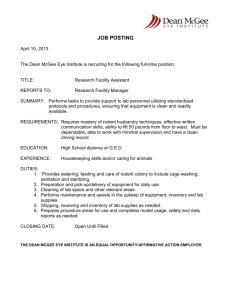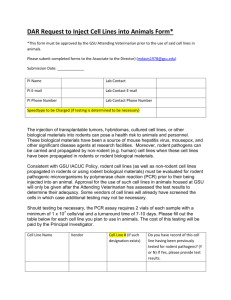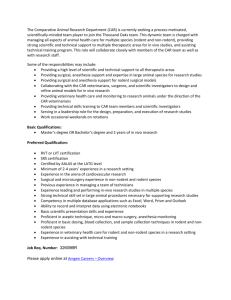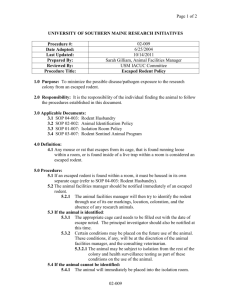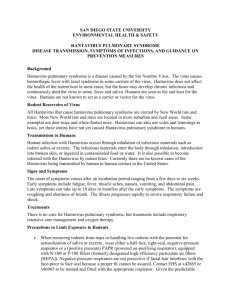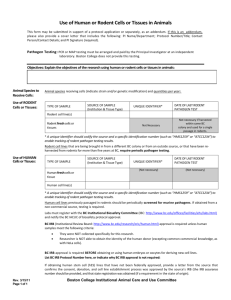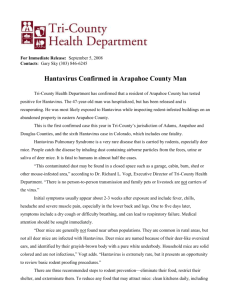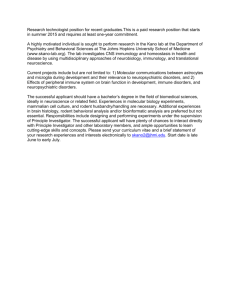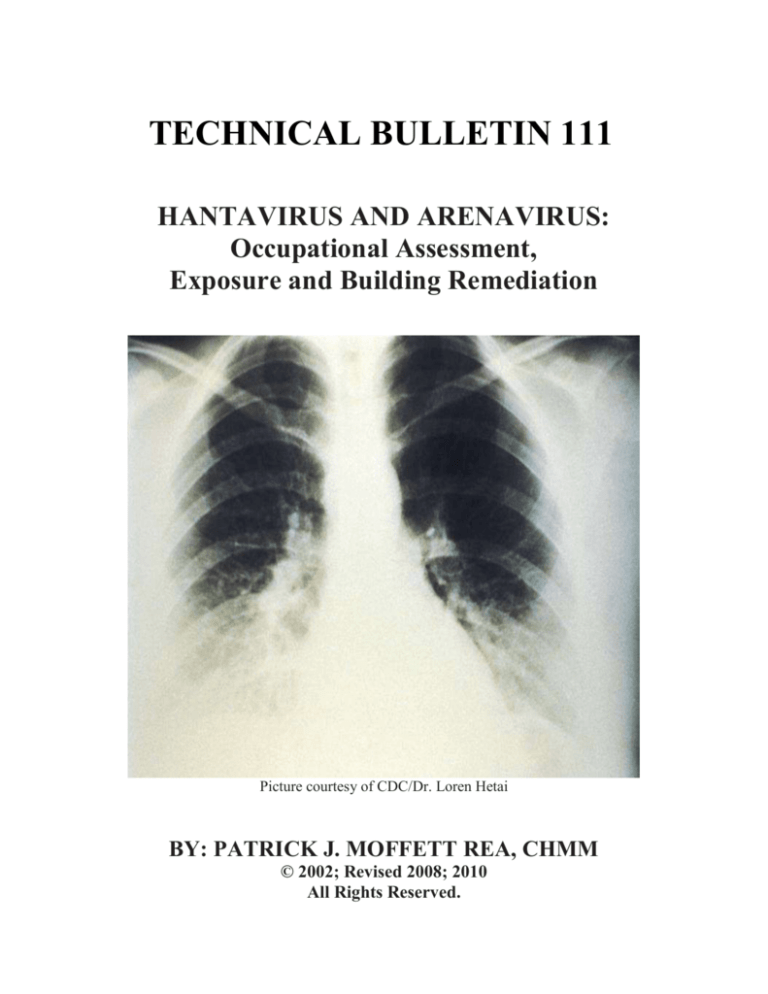
TECHNICAL BULLETIN 111
HANTAVIRUS AND ARENAVIRUS:
Occupational Assessment,
Exposure and Building Remediation
Picture courtesy of CDC/Dr. Loren Hetai
BY: PATRICK J. MOFFETT REA, CHMM
© 2002; Revised 2008; 2010
All Rights Reserved.
www.IAQHelp.com Technical Bulletin 111
TABLE OF CONTENTS:
TABLE OF CONTENTS .................................................................................................................... Page 2
Purpose for this Article ....................................................................................................................... Page 3
Where Does Hantavirus Come From? ................................................................................................ Page 4
History of the Disease and Its Consequences ..................................................................................... Page 5
Employee Symptoms .......................................................................................................................... Page 5
Employee Treatment ........................................................................................................................... Page 6
Hantavirus and Arenavirus Differences .............................................................................................. Page 6
Calling Your Local Agency ................................................................................................................ Page 8
Compliance and Regulations .............................................................................................................. Page 9
Accepted PPE for Cleanup.................................................................................................................. Page 9
Decision Logic Tree .......................................................................................................................... Page 10
Risk Management ............................................................................................................................. Page 13
Professional Cleanup ........................................................................................................................ Page 14
Closing Comments ............................................................................................................................ Page 20
About the Author .............................................................................................................................. Page 21
2
Copyright © 2002; Revised 2008; 2010 Patrick J. Moffett. All Rights Reserved
www.IAQHelp.com Technical Bulletin 111
HANTAVIRUS AND
ARENAVIRUS
PURPOSE FOR THIS ARTICLE
A previous version of this article was published for western U.S. smoke and fire damage restoration
contractors (restorers) who are exposed to mice populations. Restorers are cleaning and deodorizing
homes and businesses from community-wide wildfires. Because of wildfires, the northern and southern
California population of field rodents migrate into the surrounding building community because of a
lack of food and shelter. While hantavirus or arenavirus is in every county in California, the viruses are
also present in most U.S. states and Canadian provinces.
Restorers are unknowingly expose employees, temps and subcontractors to dangerous health
situations when they enter rodent infected buildings. It is believed that restorer’s employees are facing
higher exposure levels of dust potentially having hantavirus and the new world arenavirus when they
crawl in attics and under the buildings or anytime they disturb settled dust that can easily become
airborne.
This article is meant to advise restorers that potential exposure to hantavirus and arenavirus cannot
be seen just because you see settled dust. The main indicator of the presence of rodent borne viruses is
seeing their feces and urine or their nesting and other physical signs. Also, this article is designed to
create a heightened awareness that a risk management processes must be completed before allowing
employees to work in and under potentially contaminated buildings. Meaning, anytime restorers crawl
into and under buildings, appropriate personal protective clothing is required. Working around buildings
where mice or rat droppings and urine is present requires immediate risk management decisions to be
made. Exposure to rodent-borne viruses seldom occurs but when it does, the exposure results to
employees are a high fatality rate.
3
Copyright © 2002; Revised 2008; 2010 Patrick J. Moffett. All Rights Reserved
www.IAQHelp.com Technical Bulletin 111
WHERE DOES HANTAVIRUS COME FROM?
“Hantavirus, a distant cousin of the Ebola virus, is a rare, serious respiratory disease. The earliest
identified case in the United States was in 1975. This disease gained national attention in September
1993 when 17 people died from it in the Four Corners area of the southwestern United States where
Arizona, New Mexico, Colorado, and Utah meet” (Oregon OSHA, Standards and Technical Resource
Section).
The primary disease-borne rodent is the common deer mouse that is found in every county in
California and many other U.S. states and provinces in Canada. The deer mouse (Peromyscus
maniculatus) cannot be easily distinguished from other mice and small rats; neither can we identify the
difference between virus infected and unaffected feces and urine just by looking at it. “There is no way
to tell an infected rodent from a non-infected rodent by visual inspection. It is also difficult at times to
differentiate deer mice from other rodents. Therefore, all rodents should be treated as potentially
infectious and regarded with proper precautions” (County of Riverside California, Office of
Environmental Health).
It is believed hantavirus that is affecting the deer mouse population is not new and it has been
among the deer mouse population for a long time. Only recently have scientists been able to identify the
virus (CDC). Hantavirus pulmonary syndrome (HPS) is a recently recognized viral zoonosis. The first
recognized cases were caused by a newly described hantavirus – Sin Nombre virus (previously known
as Muerto Canyon virus) that was isolated from Peromyscus maniculatus (deer mouse) (American
Journal of Medicine Jan. 1996).
While the deer mouse (Peromyscus maniculatus) that spreads hantavirus is the most common
human vector, the first evidence that New World rodents spreading the arenaviruses occurred in Los
Angeles and Orange counties and northwestern San Diego County, and the first evidence that
Peromyscus and Reithrodontomys rodent species are naturally infected with New World arenaviruses
into other mice populations including rats which carry arenaviral infections.
Besides the California mouse Peromyscus californicus, other mice and rats carry dangerous viruses
including the white-throated wood rats in Colorado, white-footed mouse in New York State and
Pennsylvania, house mice (Mus musculus) in Maryland, wood rats in Arizona, Utah, Texas and New
Mexico, rice rats in Texas to cotton rats in Florida. While the deer mouse isn’t known to live in
Louisiana, the vector for causing the Bayou virus, also a hantavirus, possesses a different rodent
reservoir vector yet to be discovered.
4
Copyright © 2002; Revised 2008; 2010 Patrick J. Moffett. All Rights Reserved
www.IAQHelp.com Technical Bulletin 111
HISTORY OF THE DISEASE AND ITS CONSEQUENCES
Hantaviruses are a family of four previously-identified viruses found in rodents. Besides the U.S.,
these viruses cause serious health problems in other parts of the world including the Far East and
Scandinavia; and it was a source of illness affecting American troops in 1952-53 during the Korean
Conflict.
The virus responsible for U.S. deaths in the past 50 years is a fifth strain that is apparently unique to
North America. The North American strain attacks the lungs instead of the kidneys as the other four
strains do. The North American medical term for the hantavirus disease is called Adult Respiratory
Distress Syndrome (ARDS) and it is also known as Hantavirus Pulmonary Syndrome (HPS). “The
causative agent of HPS is the Sin Nombre virus, a previously unknown hantavirus that was both
documented in individuals with HPS” (Los Angeles County Public Health).
Hantaviruses have evolved with specific rodent hosts such as the Deer Mouse. In humans, infection
can result in severe complications and a high rate of mortality. Worldwide, there are over 100,000
clinical cases per year of hantavirus disease. The primary syndrome caused by hantaviruses in the New
World is Hantavirus Pulmonary Syndrome (HPS) which has a mortality rate of approximately 45%
(Pacific Southwest Regional Center of Excellence).
Infected rodents shed live virus in saliva, feces and urine. Humans are infected when they encounter
and inhale aerosolized microscopic particles that contain dried rodent urine or feces. The U.S. and
Canadian strain appears to be extremely dangerous to humans who are infected with it. More than half
of the population known to be infected by the virus dies. The actual mortality rate is likely to be lower
because less severe cases probably go undetected and diagnosed. While hantavirus is dangerous, its
means of transmission is so unusual that most people are very unlikely to encounter the virus, however,
it poses little threat to the general California population but it poses a higher rate of infection to workers
who must work in and clean up rodent infestations or work in extremely dusty buildings.
EMPLOYEE SYMPTOMS
Illness is typically detected in one to two weeks but the range may be as wide as a few days and up
to six weeks. The Adult Respiratory Distress Syndrome (ARDS) initially appears similar to the flu
where high fever, muscle aches, coughs and headache occurs. However, in some cases after several
days, respiratory problems increase where the lungs fill with fluid and the person dies from respiratory
failure.
5
Copyright © 2002; Revised 2008; 2010 Patrick J. Moffett. All Rights Reserved
www.IAQHelp.com Technical Bulletin 111
EMPLOYEE TREATMENT
At the moment, it appears there is no generally effective treatment for hantavirus. Physicians
experiment by administering ribavirin, an antiviral drug, to infected patients. Too few people have been
treated to draw any conclusions about the ribavirin treatment’s effectiveness.
Persons with arenavirus may fair much better as far as clinical treatment is concerned. There is
presently only one vaccine for arenavirus infection; the live attenuated Junin Candid 1 vaccine. In a
double blind study in 6500 male agricultural workers in the endemic area, the vaccine was found to be
effective and without adverse effects. The Candid 1 vaccine is licensed as an investigational new drug in
the U.S. (Pacific Southwest Regional Center of Excellence).
HANTAVIRUS AND ARENAVIRUS DIFFERENCES
Common Vectorborne Routes
To a layperson being infected by one virus over another is not significant. They are concerned about
health implications and what can be done to make them well again. Both hantavirus and arenavirus are
generally spread to humans by rodent contact that include inhalation of aerosolized droplets of urine and
feces and the respiratory saliva secretions of rodents (CDC). Other means of infection include but are
not limited to the inhalation of dust or other organic matter contaminated with infectious virus and
contact of infectious materials.
Hantaviruses occur in wild rodents throughout the world, who shed it throughout life in urine and
feces. Transmission occurs between rodents. Transmission to humans is through inhalation of aerosols
of rodent excreta. Recent evidence suggests human-to-human transmission may occur on a rare occasion
(MERCK).
Hantavirus and Arenavirus
As already stated, hantavirus pulmonary syndrome (HPS) is a frequently fatal rodentborne viral
zoonosis. The virus family Arenaviridae, genus Arenavirus, includes 3 North American species. The
North American species are Bear Canyon virus (BCNV), Tamiami virus (TAMV), and Whitewater
Arroyo virus (WWAV). The human health importance of the North American arenavirus species has not
been rigorously investigated. Specific members of the subfamilies Neotominae and Sigmodontinae in
the rodent family Cricetidae are the principal hosts (reservoirs) of the hantaviruses known to cause HPS
in North America and the 3 North American arenaviruses.
6
Copyright © 2002; Revised 2008; 2010 Patrick J. Moffett. All Rights Reserved
www.IAQHelp.com Technical Bulletin 111
CDC Says:
The rodent hosts of arenaviruses are chronically infected with the viruses; however, the viruses do
not appear to cause obvious illness in them. Some Old World arenaviruses appear to be passed from
mother rodents to their offspring during pregnancy, and thus the virus remains in the rodent population
generation after generation. Some New World arenaviruses are transmitted among adult rodents, likely
via fighting and inflicting bites. Only a portion of the rodents in each host species is infected at any one
time, and in many cases only in a limited portion of the host’s geographical range. The viruses are shed
into the environment in the urine or droppings of their infected hosts.
Human infection with arenaviruses is incidental to the natural cycle of the viruses and occurs when
an individual comes into contact with the excretions or materials contaminated with the excretions of an
infected rodent, such as ingestion of contaminated food, or by direct contact of abraded or broken skin
with rodent excrement. Infection can also occur by inhalation of tiny particles soiled with rodent urine
or saliva (aerosol transmission).
The types of incidental contact depend on the habits of both humans and rodents. For example,
where the infected rodent species prefers a field habitat, human infection is associated with agricultural
work. In areas where the rodent species’ habitat includes human homes or other buildings, infection
occurs in domestic settings.
Some arenaviruses are associated with secondary person-to-person and nosocomial (health-care
setting) transmission. This occurs when a person infected by exposure to the virus from the rodent host
spreads the virus to other humans. This may occur in a variety of ways. Person-to-person transmission is
associated with direct contact with the blood or other excretions, containing virus particles, of infected
individuals. Airborne transmission has also been reported in connection with certain viruses.
Contact with objects contaminated with arenaviruses materials, such as medical equipment, is also
associated with transmission. In these situations, use of protective clothing and disinfection procedures
(together called barrier nursing) help prevent further spread of illness. In the environment the public and
workers are being warned about coming in contact with rodent infestations or dusty, dirty and vacant
buildings. Also, the public is being warned about contact with dusty garages, storage areas, attics and
crawlspaces.
_____________________
Arenaviruses are rodent-borne enveloped RNA viruses that are now classified as potential
bioterrorism agents by the Centers for Disease Control and Prevention (CDC). Importantly, five
members of the arenavirus family are capable of causing severe hemorrhagic fevers in humans. They are
considered Category A bioterrorism agents because of the combination of high morbidity/mortality rates
and airborne transmission (Pacific Southwest Regional Center of Excellence).
7
Copyright © 2002; Revised 2008; 2010 Patrick J. Moffett. All Rights Reserved
www.IAQHelp.com Technical Bulletin 111
CALLING YOUR STATE AGENCY
ENVIRONMENTAL PROFESSIONAL
OR
YOUR
INDOOR
In California if you are concerned about signs of rodent feces and urine contact your local County
Department of Public Health Agency and more importantly, their division called Environmental Health
Services. Sometimes Environmental Health Services will refer you to another department or division
called Vector Control. Don’t think you are getting the run-a-round because each bureau has a different
function and responsibility. In answering medical questions all agencies will tell you to seek qualified
advice from your medical doctor or emergency medical assistance if you think you have been infected.
More than likely an environmental health enforcement officer will not come out as a first responder
to your situation unless the community is known to have an active outbreak of hantavirus or arenavirus.
Generally the County Vector Control (rodent trapping agency) will come out first and see what is going
on. If you are already working in a building having rodent droppings and urine, your employee exposure
to disease causing viruses may have already occurred by the time Vector Control gets there.
County Vector Control officials and even the county environmental health enforcement officer is
limited on what they can say or do, other than to tell you to stay out of rodent infested environments,
and if you attempt to clean up rodent feces and urine yourself, you should do so with proper precautions
such as those outlined in this article.
Hantavirus bulletins and fact sheets will be mailed to you or you can pick them up from Vector
Control agencies. For example:
The County of San Bernardino Environmental Health says: “Deer mice are the most abundant,
widely distributed and probably the most common carrier of the virus. It is difficult to properly
identify [deer] mice. All rodents should be avoided.”
Chris Conlan, the San Diego County of Environmental Health’s supervising vector ecologist said
in a recent article “a broom plus mice droppings equals bad.”
The County of Riverside Environmental Services Division says, “Deer mice are abundant
throughout California, especially in rural and semi rural areas. These mice will readily enter
people’s homes, work places, and other buildings for food and shelter. You can tell if a building
is rodent infested by sighting live mice (especially at night) or observing carcasses, droppings,
urine stains, nests, or signs of rodent chewing.”
The County of Los Angeles Environmental Health says, “…late spring and summer is the usual
peak period for hantavirus infection.”
For a live video broadcast of hantavirus issues go to:
http://www.videomd.com/HantavirusPulmonarySyndrome-fv-749.aspx
8
Copyright © 2002; Revised 2008; 2010 Patrick J. Moffett. All Rights Reserved
www.IAQHelp.com Technical Bulletin 111
COMPLIANCE AND REGULATIONS
Outside of a research or clinical laboratory setting, hantavirus and arenavirus are not believed to be
a regulated state of California biohazardous waste. However, the improper handling and management of
potential hantavirus and arenavirus contaminated materials; or a willful disregard for protecting the
public and cleanup workers, may fall under different state jurisdictions such as DOH, DEHS, EPA and
OSHA.
ACCEPTED PPE FOR CLEANUP AND SANITIZING
Restorers who are trained in remediating fire damage, chemical, sewage and water damage are
expected to be some of the more knowledgeable and skillful cleanup specialists. As such, they will have
the equipment necessary to vacuum up, clean and sanitize and dispose of rodent infected waste.
Once employees (trained technicians) are informed about the hazards they face, the restorer can
start with the cleanup once technicians have appropriate PPE and engineering controls are established.
Appropriate PPE in buildings include but is not limited to:
Minimum of a P-100 Face Mask
Disposable Tyvek-like (asbestos-grade) full body protective clothing
Slip-on Tyvek-like booties
Double glove with inner glove being a thin surgical-like latex glove; rubber Playtex-like outer
glove with cuffs
Non-fog goggles that are slash resistant
Commonly Relied Upon Engineering Control and Cleanup Equipment:
Air Scrubber with HEPA filtration
Negative air pressure machine with HEPA filtration
Wet/dry vacuum with HEPA filtration
Walk-off mats
6-mil plastic for containments
6-mil plastic commercial trash bags
Masking and duct tape of various sizes and adhesive strength
Cleanup equipment including hand washing (sponge mops, buckets, wringers)
Cleanup equipment including electric machine washing (floor scrubber)
Detergent cleaners and California EPA registered sanitizers and disinfectants
Sanitizing equipment including wet steam (150 - 300 psi @ 300F)
9
Copyright © 2002; Revised 2008; 2010 Patrick J. Moffett. All Rights Reserved
www.IAQHelp.com Technical Bulletin 111
DECISION LOGIC TREE (DLT): LOGISTICS MANAGEMENT
A decision logic tree (DLT) is designed by the restorer to discuss actual jobsite problems
(complications, complexities, limitations, restrictions and conflicts) with the customer so they both can
address specific project management concerns. Once everyone agrees on a problem solving approach,
the restorer completes the work per the contract and completes it safely.
A “what if” and “what to do next” set of scenarios is expected to be asked by all materially
interested parties (before work begins) so the restorer can answer them intelligently. Attempting to
answer these types of questions (after the work is completed) sometimes cannot be answered to the
satisfaction of the customer or property manager, insurance adjuster or health department, because the
questions and response could not have been anticipated. The DLT is intended to help all parties
understand what will occur in what order and what the most probable outcome will be at the completion
of work.
Sometimes the DLT created by the restorer may not work when the customer or a third party
doesn’t agree to the proposed cleanup or sanitizing procedure such as: certain aspects of the cleaning,
deodorizing or sanitizing process is not required; urine-saturated upholstery, books and carpet do not
need to be disposed; ventilation systems do not need to be cleaned and sanitized; attic insulation can
stay. In this scenario the DLT was able to point out key contamination, sanitizing and disposal issues. I
suggest that an official tick-list of services should be outlined by the restorer and submitted to their
customer, where the customer initials that they accept or reject each item and service.
In another example, the DTL may include and identify to the customer what type of cleaners,
sanitizers and disinfectants will be used, how they will be applied and what materials (finishes and
surfaces) they will not be used.
Using the above example: Chlorinated cleaners and sanitizers that are OK to wash and clean kitchen
ceramic tile and grout may not be appropriate for:
Marble surfaces;
Hardwood floors and wood finish contents;
Metal having patina or a coated finish;
Clothing and fabric upholstery;
Dishes and utensils;
Electrical and electronic appliances;
Laminate surfaces;
Surfaces that easily scratch;
Leather chairs and leather bound books;
Artwork and antiques;
Children’s toys;
Pictures and photo albums.
10
Copyright © 2002; Revised 2008; 2010 Patrick J. Moffett. All Rights Reserved
www.IAQHelp.com Technical Bulletin 111
After consulting with many restorers over the years, here is my interpretation about some of their
jobsite challenges that should have required a DLT. I’ve also included some of my own DLT customer
concerns. What will be your response to customers when they ask:
1. Is the cleanup of rat/mice droppings and urine a potentially hazardous job?
2. Rat/mice droppings and urine are on my carpet, fabric upholstery and bedding. What are you
going to do to remove the feces and stains?
3. Rodents started eating my stored food, cosmetics and medication; do they need to be disposed?
4. In my garage I stored family photos and legal documents. We can see mice droppings and
evidence of chewing on the boxes and photos and legal papers. Can my contents be sanitized or
do they need to be destroyed?
5. I have no concerns. I was told by my insurance company you are the professional. Therefore,
when we take possession of our home after you complete your work, we expect the home and its
furnishings and contents will be given back to us as if nothing happened.
6. If you can’t just sweep up the mess how are you intending to get rid of the feces?
7. We found dead mice and droppings near our HVAC system; can we use the air conditioner?
8. Can’t you just cleanup and deodorize my house at the same time you’re cleaning up mice feces?
9. Our attic has droppings all over it. How do you get out the droppings and urine from the
insulation without removing it?
10. When you’re doing your cleanup work do we have to move out again?
11. We have 2 dogs and 3 cats. Are you going to clean up the rat pee and leave my cat pee behind; or
are you going to remove all the urine and feces including the fire odor smell?
12. I’m chemically sensitive to chlorinated solvents. What chemicals are you planning to use in
cleaning, deodorizing and sanitizing my home and contents?
13. The fire was devastating around us and we have extensive smoke damage so we have not lived in
the home for several months. It appears that when we left, the mice, rats, opossums and other
critters moved in. What do you do first; trap all the critters and remove their feces; do you start
with the smoke odor cleanup and deodorization?
14. You’re treating my house as if it has the plague, is this necessary?
15. Now that I got rodent feces on my contents and house, what assurance will I have that
everything you cleaned is sanitary?
16. I don’t know what to ask you to do first, take care of my rat-infested contents or attempt to
sanitize and deodorize the smoke damaged building?
17. I don’t care what you do to sterilize my home. I’m not accepting any carpet, pad and soft goods
unless you can prove to me they are back to their pre-loss sanitary condition.
18. Now that I have rodents in the house, I believe I have the same problem in my crawlspace. How
do you cleanup feces and urine-saturated soil?
19. Our house is actually a second home that we rent out. What are you going to tell the tenants
about what they should do with their contents so you can take care of our smoke odor and feces
damaged home?
20. You’re the professional so I want your advice: What do we save and what do we dispose?
21. My insurance company hired you to remove soot and clean and deodorize my home. Now you
are telling me, because of a couple of rats that came in my house and crapped all over, you have
to remove that mess first?
22. I’m not moving back in till you give my house and my contents a clean bill of health.
11
Copyright © 2002; Revised 2008; 2010 Patrick J. Moffett. All Rights Reserved
www.IAQHelp.com Technical Bulletin 111
DECISION LOGIC TREE:
CUSTOMER INTERFACE INVOLVING RODENT CLEANUP
DURING FIRE/SMOKE DAMAGE REMEDIATION
ISSUE: CONTRACTOR WANTS TO SEPARATE
CONTENTS FROM STRUCTURE TO CLEAN
AND SANITIZE THEM SEPARATELY
CONTENTS
Clean/Sanitize
Rodent
Contaminated
Contents
Dispose
Rodent
Contaminated
Contents
STRUCTURE
Carpet and Pad
to be Saved or
Disposed?
If Carpet Must
be Disposed is
it Because of
Rodent or
Smoke?
Can the soot/smoke odor be
removed at the same time rodent
infestation is being completed?
Can the soot/smoke odor be
removed at the same time rodent
infestation is being completed?
YES
Are any Contents in the Way of
Cleaning, Deodorizing and
Sanitizing the Structure?
NO
HEPA Vac and Clean Rodent
Contaminated Contents First
HEPA Vac and Clean Smoke
Damaged Contents Second
YES
NO
What Must Be Done to Protect the
Contents and What is Our Liability?
What Complications, Complexities and Limitations
must we put in a Change Order because contents
remain on the job or they may become re-contaminated
by rodents once they are sanitized?
12
Copyright © 2002; Revised 2008; 2010 Patrick J. Moffett. All Rights Reserved
www.IAQHelp.com Technical Bulletin 111
FROM A RISK MANAGEMENT POINT OF VIEW: WHAT ARE
RESTORERS EXPECTED TO DO?
1. Provide employees and customers with a copy of this article and discuss it.
2. Create a worksite “Tailgate Meeting and Awareness Program” that educates employees and
subcontractors.
a. Identify any situation where mice, rats and other rodents exist or are seen, whether or not
they are dead or alive.
b. Identify all areas where rodent feces and urine is found.
c. Make the determination – the presence of rodent feces and urine is presumed to be
infected and it is a biohazardous waste until scientifically proven otherwise.
d. Workers must wear appropriate PPE anytime they enter an attic or crawlspace and
anytime conditions and situations are present which may suggest an exposure issue could
exist.
e. Restorers are to inform employees:
i. Not following contractor’s directives may cause a health exposure to occur which
can be life threatening.
ii. Not wearing and maintaining appropriate PPE is an OSHA violation and as such
it will result in “immediate” disciplinary action.
3. Notify workers that the primary carrier for the spread of hantavirus is from aerosolized dust;
therefore, no type of air movement will be allowed until rodent feces and urine is cleaned up and
surfaces are sanitized.
a. Air Movement in Rodent Infested Environments:
i. Employees should not install any type of fan-type air movement (unless it is a
calculated and well thought out as an engineering control).
ii. Employees should not turn on the building’s HVAC where rodent feces and urine
is at or near a ventilation system supply or return.
b. Dust Disturbance in Rodent Infested Environments:
i. Employees should not:
1. Walk through rodent feces and urine residue without wearing appropriate
PPE and disposable booties.
2. Remove items in a garage storage area or house that has settled dust on
them.
3. Broom or sweep dust and dirt.
4. Building or Area Security:
a. Keep the public, building occupants and not needed employees out of areas where known
or suspected rodent droppings and urine is present.
b. Place appropriate signs on doors that restrict area entry to authorized personnel only.
c. Some situations may require signage such as “Danger Do Not Enter: Inhalation Hazard.”
13
Copyright © 2002; Revised 2008; 2010 Patrick J. Moffett. All Rights Reserved
www.IAQHelp.com Technical Bulletin 111
PROFESSIONAL CLEANUP, SANITIZING AND DEODORIZING
Take a damp sponge and wipe the feces up. With a solution of household bleach on a sponge
apply it on the urine affected surface and clean it. Some environmental health agencies may be passing
on this rather simplistic approach to mitigate rodent infestation. Yes, sometimes the most simple and
direct method is the ideal one. However, professional cleanup and remediation contractors do not get the
easy jobs. They get jobs that require them to complete an OSHA required hazard assessment before
starting work and PPE and other forms of worker protection. In addition their jobs usually include
inventorying contents, packing them and removing them to a cleaning plant for temporary storage;
cleaning, deodorizing and sanitizing the structure and bringing it back to its pre-loss condition (clean
and sanitary state).
Rodent Feces and Urine Cleanup and Sanitizing in Smoke Odor Environments:
Once the DLT makes sense and the contractor signs the contract, the first goal is to create a safe work
environment for their employees. Depending on the job and the extent of rodent and smoke odor damage
the situation may require the following steps:
Safety Warning:
o Broadcast spraying, wet fogging, thermal fogging or atomizing disinfectants in indoor air
most likely is a violation of the chemical manufacturer’s product usage and warrantee
statement; it may also be an EPA/AQMD violation; OSHA violation and FIFRA
violation.
o Appropriate PPE must be worn on jobs where there is a presumed presence of having
contact with hantavirus, arenavirus or other disease-causing agents or where there is the
likelihood or potential the environment may result in injury or illness.
o Restorers must follow all OSHA regulations including the General Duty Clause.
o Restorers who are responsible for the cleanup of rodent feces and urine have the duty to
inform building occupants about the kind of hazards that may be present and a duty to
protect building occupants and the public from coming in contact with rodent
contaminated spaces.
o The restorer must have full custody, care and control of the affected areas until such time
the restorer can safely release the building or affected area back to the property owner.
Ventilation or Not:
o When the building can be opened to outside air to where the cleanup process will not
affect or compromise the health of building occupants and the public, it is considered
reasonable and appropriate to open up and aerate the building with fresh air for a
minimum of 30 to 60 minutes before disturbing contents or attempting the cleanup of
dust and feces.
o When the building must be kept closed because of the presence of occupants and the
public or the environment must be kept secured for a number of reasons, it is considered
reasonable and appropriate to seal-up the building and install negative air pressure to the
affected rooms.
14
Copyright © 2002; Revised 2008; 2010 Patrick J. Moffett. All Rights Reserved
www.IAQHelp.com Technical Bulletin 111
Separation and Cleaning of “Salvageable” Contents, then Moving them from Affected
Areas (rodent and smoke and odor):
o Identify non-affected rooms where surface cleaned contents can be temporarily stored
onsite.
o Inventory contents to be salvaged followed by:
HEPA vacuum all surfaces of loose dust and debris.
Appropriately wash the outside surface area of contents as a “first cleaning and
damp-cloth towel drying process.”
Carefully remove contents to the control room (if there is one) or a staging area
for boxing and removal from the house to an offsite location.
Carefully plastic seal or shrink-wrap large or heavy items that must remain in
place after they are cleaned, sanitized and towel dried (e.g., metal file cabinets,
safe, attached bookshelves).
Separation and Cleaning of “Non-Salvageable” Contents from Affected Areas (rodent and
smoke and odor):
o Identify contents not considered cost effective to clean and sanitize or are damaged
beyond reasonable repair from rodent infestation or smoke and odor contamination.
o Inventory contents to be disposed followed by:
HEPA vacuum all surfaces of loose dust and debris.
Damp wipe the surface area of contents with disinfectant.
o General items commonly considered for disposal include but are not limited to:
Bagged or boxed food (cans and glass may be OK on a case-by-case basis)
Food in Tupperware and other plastic containers
All sanitary products (e.g., toilet tissue, sanitary napkins, Kleenex)
Open medications in non-sealed hermetic containers (manufacturer may void all
warrantee claims on medications exposed to these type of environments)
Open bars of soap, tooth brush, tooth paste, makeup, face creams, lip gloss.
Paper-based children’s toys, stuffed fabric animals, hand-to-mouth toys.
Cardboard boxes, paperback books, paper in general.
Separation of “Non-salvageable” (non-cleaned, deodorized and sanitized) Fabrics
o Identify fabrics and materials made with fabrics that are not considered cost effective to
clean and sanitize or are damaged beyond reasonable repair from rodent infestation or
smoke and odor contamination.
o Inventory fabric materials to be disposed followed by:
HEPA vacuum all non-salvageable materials before disposal to increase worker
protection and reduce cross-contamination.
Carefully bag and remove small items.
Carefully wrap and remove larger items.
Carefully cutout, bag and remove carpet, pad and area rugs.
Carefully bag draperies.
Carefully bag couch and chair cushions.
15
Copyright © 2002; Revised 2008; 2010 Patrick J. Moffett. All Rights Reserved
www.IAQHelp.com Technical Bulletin 111
Separation of “Non-salvageable” Building Parts that are Known or Highly Suspect of
Being Contaminated Such as:
HVAC flex ducting.
Attic insulation.
Crawlspace insulation attached to the first floor subfloor.
Carefully bag these items as they are being removed.
Any item that has sharp edges or has an unusual shape that may puncture a 6-mil
bag requires the item to be double bagged and taped closed.
Hard (non-porous) and Semi-Porous Finishes involving Small Area Cleaning:
o Identify areas and rooms that have visible rodent feces and urine staining.
HEPA vacuum all flat surfaces of loose dust and debris.
With a mild liquid detergent (e.g., Dawn, Tide) in a wash bucket with water
around 110F, rinse out a sponge in the detergent water and wipe the affected
surface of loose residue, allowing the surface to remain wet for about a minute.
During the wait time rinse out the same sponge in a separate bucket having water
around 110F and then use water from the detergent bucket and rewash the
affected surface.
With a separate clean sponge and fresh rinse water, wipe off surface residue and
allow surfaces to air dry.
o Special Attention:
Depending on the surface type and the extent of rodent contamination, combined
with fire smoke and odor residue, the material’s surface may require specialized
cleaning and disinfection.
Commercial kitchens (surfaces and contents) will need to follow HACCP
standards requiring one or more additional steps in the cleaning and sanitizing
process, such as applying a wet heat (steam heat) at temperatures of 300F to the
surfaces in the final sanitizing process surfaces where they almost instantly dry.
Hard (non-porous) and Semi-Porous Finishes involving Large Area Cleaning:
o As required, follow the steps above but expand them to the size of the affected area.
o Staying Focused:
The initial cleanup and sanitizing goal (first priority) is to remove rodent feces
and urine and not smoke and odor contamination. Smoke and odor will not kill
employees but exposure to hantavirus can.
If smoke and odor is removed at the same time the rodent feces and urine is being
removed so much the better.
In some situations floor cleanup and sanitizing may need to be completed twice:
When rodent feces and urine is removed
When the final house cleanup is completed
o Ceramic, marble, terrazzo, hardwood floors, vinyl tile and sheet vinyl tile flooring should
be:
HEPA vacuum all flat surfaces of loose dust and debris.
Sponge mopped with appropriate detergents in hot water (140~170F).
16
Copyright © 2002; Revised 2008; 2010 Patrick J. Moffett. All Rights Reserved
www.IAQHelp.com Technical Bulletin 111
Rinsed and then reapply a second cleaning process followed by a final clean water
rinsing and allow the surfaces to naturally air dry (or dry using negative air
pressure vented through a HEPA filter).
When possible, clean floors (and concrete slabs) using an electric floor scrubber
and remove remaining water with a wet HEPA filtered vacuum.
o Special Attention:
Soot and debris can easily become ground into pores of flooring from foot traffic.
Cleaning processes may require a detergent/degreaser with high surfactantcy to
loosen and remove organic waste, dissolve and suspend smoke odor residue (e.g.,
Dawn, Simple Green).
o Ceiling and wall washing from rodent infestation concerns generally can be combined
with the smoke and odor washing and sanitizing process.
Porous Materials involving Small and Large Area Cleaning:
o Special Attention Discussion:
Some porous materials may not have a sealant on them such as painted drywall or
a sealer on wood or concrete.
The cleaning priority remains the same – first safely remove the rodent feces and
urine before you think about the smoke and odor from the wildfire.
Removing saturate rodent urine from porous materials may be as simple as HEPA
vacuuming dried, loose debris followed by wetting and scrubbing the surface with
a scrub brush and detergents then, rinsing and air drying.
However, removing saturated rodent urine from porous materials may not be as
simple as one may think when the end result is not to the satisfaction of the
customer or cleanup contractor.
Also complicating this issue is the fire-smoke odor. Generally it is the porous
materials that trap and retain smoke and soot debris and smoke odor.
Depending on the severity and extent of damage and contamination it may be
more cost effective and time saving to remove porous unfinished drywall and
wood paneling and replace it.
Unfinished drywall includes the interior wall cavity facing side of drywall
that in some situations may be the source of residual and trapped smoke
odor.
Unsealed porous wood paneling and open beam ceilings have their own set of
problems. Generally it is not from rodent infestation, the problem is associated
with the wildfire smoke and odor.
Washing and deodorizing unfinished wood may change the wood’s patina
and color, it may scratch some softwoods, or striation lines may appear
because of the cleaning process after the wood dries.
Putting a sealer or encapsulate on open-pore wood may destroy its natural
appearance.
17
Copyright © 2002; Revised 2008; 2010 Patrick J. Moffett. All Rights Reserved
www.IAQHelp.com Technical Bulletin 111
Disposal of Waste:
o While rodent infested items may be extremely hazardous to your health, they are not
known to fall under a biohazardous classification or regulation as a regulated hazardous
waste unless the waste is in a laboratory.
o Currently there are no known county or state regulations which prohibit the disposal of
rodent feces and urine contaminated construction materials, carpet, pad and contents.
o Depending on local zoning, it may be OK to burn small amounts of contaminated waste
on site. However, many rural and city burning requirements, especially for infectious
waste, may say otherwise.
o It is believed that most all sealed bags and plastic sealed items can be processed without
license or manifest and disposed of at a county landfill. In other words, it is believed
small amounts of rodent feces and waste can be picked up with other city or county trash
collection as long as the bags are properly sealed. However:
o When the remains of larger amounts of contaminated items including carpet are to be
disposed CDC recommends, “All [potentially] infectious waste materials from cleanup
operations should be double-bagged, labeled as infections and disposed in accordance
with local regulations for infectious waste” (MMWR July 26, 2002/Vol. 51/No. RR-9).
Contractor’s Cleanup of Equipment:
o All equipment used at a presumed or known hantavirus job is considered contaminated
until the equipment is appropriately cleaned and sanitized.
o General industry practice requires:
Employees handling contaminated equipment must be trained on how to take
apart, then clean and sanitize all items and on how to identify items that require
bagging and disposal (e.g., pre-filter and HEPA filters, vacuum bags).
All equipment is expected to be cleaned outdoors at the jobsite in fresh, outdoor
air.
Equipment that is not cleaned and is brought back to a warehouse or cleaning
plant must be:
Plastic or shrink-wrapped sealed before it is put on a truck;
Quarantined and segregated from all other equipment;
Tagged-out as “Contaminated: Do Not Use” including the date and the job
the machine came from;
Not put back in service until the equipment is documented to be clean and
sanitary for reuse;
A paper trail should be created and kept in the customer’s job file and the
contractor’s equipment routing file for all equipment used on that job.
Sponge mops, sponges, rags and other cleaning supplies used on the job are to be
bagged and disposed.
Disposable PPE is to be bagged and disposed.
18
Copyright © 2002; Revised 2008; 2010 Patrick J. Moffett. All Rights Reserved
www.IAQHelp.com Technical Bulletin 111
The personal clothing of employees is to be inspected--including street shoes.
Any chance or opportunity for employee street clothing to become
contaminated requires the clothing to be removed and cleaned by the
contractor and not the employee:
o Employees must not be allowed to go home or expose the public or
their family to potentially contaminated clothing.
o Potentially contaminated clothing should not be washed with other
clothing or fabrics.
Medical Surveillance:
o All jobs where a biohazardous condition is known or presumed to exist require the
contractor to implement key elements of their Injury Illness and Prevention Program
(IIPP) including the Exposure Control Plan (ECP).
The site-specific health and safety plan (SSHSP) must be established before
cleanup and remediation process begins.
In fact, a model of the SSHSP should be in place before the job hazard assessment
(JHA) is completed (inspecting the job site, climbing in attics and crawlspaces).
o All employees who have a risk of biological exposure to suspect hantavirus and
arenavirus environments or an injury and illness exposure occurs because of work
conditions, they require immediate medical assistance and a follow-up through a medical
surveillance evaluation plan.
Consult with your environmental medical health practitioners on creating a
medical surveillance evaluation plan.
o Workers involved in the cleanup who develop a febrile or respiratory illness within 45
days of the last potential exposure should immediately seek medical attention and inform
the attending physician of the potential occupational risk of hantavirus and arenavirus
infection.
The physician should contact local health authorities promptly if hantavirus and
arenavirus associated illness is suspected. A blood sample should be obtained and
forwarded through the state health department for hantavirus and arenavirus
antibody testing.
19
Copyright © 2002; Revised 2008; 2010 Patrick J. Moffett. All Rights Reserved
www.IAQHelp.com Technical Bulletin 111
CLOSING COMMENTS
In a survey of restorers who are involved with building cleanup and deodorization from communitywide wildfires, it appears they are unaware of the potential health hazards and hazardous work
conditions involving hantavirus and arenavirus. Employees and day laborers were not being educated
about the warning indicators involving rat and mice feces and urine found in and under buildings.
Since my initial survey several years ago, I provided restorers with a draft copy of this article. Many
restorers replied: they never knew the seriousness mice and rat droppings may cause and the health
consequences that can affect workers, building occupants and the public.
Restorers ask me if rodents entering buildings from wildfires represent a unique situation because
they often find rodent droppings on jobs. They say, most times rodent droppings are found in basements,
attics, crawlspaces, garages and storage areas. My reply is consistent with many departments of health
and human services: “All rodent droppings and urine must be carefully cleaned up because we don’t
know if a virus is present or not.”
I recently taught at the University of Victoria in Canada where the focus of my course dealt with
biological contamination and remediation in and under buildings. From students in the class I found out
there are confirmed cases of hantavirus in the provinces as well. Subsequent research reports British
Columbia, Alberta, Saskatchewan and Manitoba population have been exposed to Sin Nombre viruses
with the first reported case dates back to 1989. To date, hantavirus infected mice have been found in
every province except Prince Edward Island and Nova Scotia and the Northwest territory. The Public
Health Agency of Canada (PHAC) says the incubation period of the disease is 9 to 35 days and the
Canadian mortality rate is slightly less than the U.S. which stands at 38%. Canadian health and U.S.
public health agencies agree that prevention of the disease comes through public awareness,
understanding the risk of exposure and adopting appropriate preventive practices.
The Canadian OSHA (Canadian Centre for Occupational Health and Safety – CCOSH) and U.S.
OSHA are consistent with worker health and safety requirements and what is required to protect workers
in their workplace. CCOSH suggestion for workers who work in dusty buildings where there is a high
amount of rodent droppings, “it is necessary to wear powered air purifying respirators (PAPR) having
high-efficiency particulate air (HEPA) filtration or air-supplied respirators.”
One person asked me: Is this article meant to be a scare tactic to provide workers with unnecessary
and burdensome PPE including unrealistic work and cleanup procedures? My reply was no. “Exposure
to hantavirus and arenavirus are exceptionally low. However, it is believed persons who became
seriously ill or died would be alive and healthy today if they had and followed their health department,
CCOSH, OSHA and CDC information bulletins. My goal is to provide as much information to cleanup
and remediation contractors as I can in an attempt to protect their employees, building occupants and the
public.”
Finally, your typical indoor environmental professional (IEP) who may be great at assessing water,
sewage and mold damaged buildings. However, they may be clueless on what to do or recommend to all
parties in a rodent infestation situation. As the restorer, consider providing your IEP with a copy of this
article so they can better informed about specific job site employee health and safety and cleanup,
sanitizing and disposal issues.
20
Copyright © 2002; Revised 2008; 2010 Patrick J. Moffett. All Rights Reserved
www.IAQHelp.com Technical Bulletin 111
About the Author:
Patrick Moffett is a senior consultant and partner of Environmental
Management & Engineering, Inc., located in Huntington Beach California.
Patrick is a licensed general contractor in several states, a California
registered environmental assessor, certified hazardous materials manager,
master restorer, senior environmental/industrial hygienist, certified building
science thermographer; and he holds other certifications in water, mold and
fire damage building remediation and restoration.
For over 25 years Patrick lectures and teaches classes across the U.S.,
Canada and U.K., on remediating chemical and biological contamination in
buildings; OSHA safety codes and regulations.
Patrick has published over 50 articles and 5 books on environmental and
building remediation practices.
Patrick provides mediation, arbitration and expert witness testimony across
the U.S. involving causation associated with water, mold, sewage and fire
damaged properties; Patrick also provides expert testimony in industry
standards of care and OSHA compliance.
Contact Patrick Moffett through his office phone: 714-379-1096. Cell
phone: 714-928-4008. Email PMoffett@emeiaq.com or PatMoffett@att.net.
21
Copyright © 2002; Revised 2008; 2010 Patrick J. Moffett. All Rights Reserved

